Shinta Obong: A Scent That Refuses to Burn
A self-initiated scent project inspired by Indonesian mythology, combining chemistry, storytelling, and emotion in one bottle. An exploration of identity through fragrance.
How I Turned Fire, Folklore, and Fragrance Into a Cultural Statement
I always believe that the most powerful form of learning happens at the intersection of disciplines. Where chemistry meets poetry. Where culture meets design. Where storytelling isn't confined to words, but expands into scent, texture, silence.
That belief isn’t just theoretical for me. It shapes how I create.
I come from a background in chemistry, but I’ve always been drawn to stories—especially the kind that live on skin. Over the years, my fascination with scent grew from personal obsession into practice: curating fragrances, writing perfume reviews, and slowly teaching myself the language of aroma through exploration, failure, and instinct. I never went to perfumery school. But I built a world of scent anyway.
When I found out about the Aromatika Indofest 2025—a national perfume formulation competition hosted by Indonesia’s Ministry of Industry (KEMENPERIN)—I saw an opportunity. Not just to submit a product, but to submit an idea. That scent can be a cultural narrative. That small creators like me can carry heritage in molecules. That experimentation is a form of storytelling.
So I created Shinta Obong.
Why Shinta?
The idea for Shinta Obong didn’t appear out of nowhere. It came to life after a conversation with a close friend—a Javanese woman deeply rooted in her cultural heritage. Someone who still watches wayang kulit with reverence, who speaks of Dewi Shinta not as a distant myth but as a living presence. In an era where many have moved away from these traditions, her perspective struck me as rare, and incredibly powerful.
We talked at length about Ramayana, not just as a story but as a system of values, a mirror of how society treats women. That conversation unearthed something in me. I began to see Shinta not only as a literary figure, but as a symbol of endurance. Of quiet resistance. Of being repeatedly tested, and still choosing to exist on one's own terms. That was the spark. The rest followed.
I almost made a perfume about Indonesia’s biodiversity. I even began sketching formulas based on clove, nutmeg, cendana, vetiver, and citrus from Sulawesi. But the more I sat with the idea, the more it felt... incomplete. It lacked the emotional core I was looking for. It felt like a catalog, not a narrative.
And then I remembered Shinta.
The story of Dewi Shinta from the Ramayana had long fascinated me—not for its romance, but for its cruelty. For the impossible demands placed on her, for the trial by fire, for her silence and her strength. In Indonesian culture, especially in Javanese and Balinese traditions, Shinta isn’t just a character. She’s a symbol. She’s been danced, carved, puppeteered, and broadcast into our collective consciousness for generations. And yet, few seem to talk about what she felt.
Shinta Obong is my response to that silence.
The Concept: After the Fire
The name combines "Shinta" and "Obong" (Javanese for "to burn"). But this isn’t a perfume about destruction. It’s about transmutation. About what remains after the fire. It’s not about proving innocence. It’s about refusing to be reduced to ashes.
In my formulation notes, I wrote: "Not a pretty scent. Not safe. But honest." That became my guiding principle.
The top opens with Clausena and yuzu, both sharp and bitter—meant to evoke the initial sting of judgment. The heart blooms with jasmine sambac, osmanthus, tuberose, and kenanga, held together by oak. Together, they form a sacred floral accord—reminiscent of temple offerings, or the scent of a dancer’s hair in mid-spin. The base is dense, smoky, and warm: patchouli, incense, vetiver, caramel, and a trace of tobacco absolute. Together, they simulate the feeling of embers that linger in the air long after the flame has gone.
It doesn’t smell "feminine". It smells alive.
Cultural Layers: Scent as Archive
There’s something deeply political in choosing a myth as a starting point. Especially a myth that has, for centuries, shaped how femininity is imagined in the region. I wanted to engage with that legacy critically, not passively. To take Shinta out of the fire, out of the need to perform purity, and give her a new medium: scent.
That decision shaped every part of the process. I researched temple rituals, incense formulas, the scent profile of candi stone after rain. I mapped memories—mine, my mother’s, strangers'—of watching sendratari Ramayana. Scent became the carrier of cultural data, emotional residue, even trauma. I read so many article. Some of that I hold dear in me.
And all of it had to fit in a bottle.
Read the inspo article here :
The Making Process: Solitude, Failure, and Smoke
This was a solo project. I did the formulation, sourcing, maceration, and evaluation myself. No assistants. No sponsors. Just me, working in a small corner of my workspace, surrounded by raw materials and notebooks filled with crossed-out formula numbers.
It took dozens of trials to get the right incense note. Too much olibanum, and it overpowered the florals. Too little, and it disappeared under the guaiac wood. I had to tweak the proportions of tobacco absolute to prevent the drydown from becoming too masculine. I learned to work like a sculptor—adding, removing, listening.

At some point, I stopped thinking like a perfumer. I started thinking like a dramatist. What is the arc of this scent? Where is the climax? What tension does the wearer carry, and what resolution awaits them on their skin?
and here’s the final aromas
Read the full “Story Behind” of what I submitted to the jury here:
Shinta Obong: Story Behind (Bahasa Indonesia, Original Version)
Shinta Obong: Story Behind (English Translation)
What I Learned
From a technical standpoint, this project deepened my understanding of structure. Not just top-heart-base dynamics, but how transitions feel. From a conceptual perspective, it pushed me to think of perfume as a storytelling device; one that interacts with collective memory, gender, and emotion.
But more importantly, it reminded me that independent creators can contribute to cultural discourse. You don’t need a million-dollar lab. You need clarity, conviction, and the willingness to fail your way into something honest.
It also affirmed what I’ve always felt instinctively: that the best ideas often come from the edges. Not the mainstream. That art, science, and design don’t have to live in separate rooms. They belong at the same table, even if they speak in different dialects.
Who It’s For
This perfume is for anyone who’s ever been asked to prove themselves. Anyone who’s walked through fire in silence. Anyone who knows that strength doesn’t always roar—sometimes, it whispers. Or lingers.
And maybe, just maybe, smells like jasmine, oak, and smoke.
Shinta Obong has been submitted to the 2025 Aromatika Indofest under the alcohol perfume category. Judged by leading Indonesian figures in the fragrance industry, the competition values technical skill, originality, longevity, and aromatic uniqueness. It’s not just a contest. It’s a stage. And I’m proud to stand on it as a small, self-driven scent creator.
Update
The Aftermath: Reformulation, from Scratch
I originally sent the sample on 18th June. On July 4th, just as the evening began to settle, I received a call from the competition committee.
They were reaching out about my submission, Shinta Obong. More precisely, about one of the ingredients I used. According to their internal review, the perfume contained a tobacco note—which, under BPOM regulation, wasn't permitted. It didn’t matter that I had used only a single drop—literally one drop—in the entire formulation. Or that I used it not as a central note, but simply to tone down and round out the overall aroma structure. The tobacco wasn’t dominant. It wasn’t obvious. It was there to ground everything else, quietly.
Still, it was flagged.
And the irony? That ingredient came from the official formulation kit—sent by the committee itself.
But rules are rules.
I was asked to reformulate the perfume and submit a new version.
At that point, I had already used up all my materials making a larger batch of the original—intentionally so, as a precaution. If Shinta Obong advanced to the final round, I wanted to be ready. I didn’t expect I’d have to rebuild it from scratch.
Thankfully, the committee sent me a new formulation kit, free of charge. The second formulation kit arrived on July 5th. I had until July 7th—just two days—to complete the reformulation and return the new sample. I appreciated the gesture. But anyone who works with scent knows that raw materials are only half the equation. The other half is time. And I no longer had that.
So I started over. I replaced the tobacco with clove. I adjusted the composition, sharpened the leathery facets, reduced the smoky trail, preserved as much of the spirit as I could. On paper, it was sound. The balance held. But something in it had changed.
The original had macerated for nearly three weeks. It had matured into itself. This new version barely had any days.
Of course, I still submitted it.
Was I disappointed? Absolutely. Not because I had to follow the rules—but because the perfume I truly believed in, the one I spent weeks crafting, the one that carried the most emotional and technical integrity—was never the one that got judged.
But I also know: this isn’t the end of Shinta Obong’s story.
What’s Next for Shinta Obong?
I’ve decided to release the original version by myself. The one I intended. The one that carried just a trace of tobacco to steady the flame.
Because I still believe in it. And because the people who smelled it before the reformulation told me, unprompted, that it stayed with them. That it had weight. That it had presence. People remembered it. It still smells like the story I wanted to tell.
And if you’re someone who listens to scent the way you’d listen to a story—you’ll understand why I’m choosing to share it anyway.
Stay tuned for Shinta Obong: Original Edition. Limited release, full story. :)
from Runnilune, still listening to fire.
Written by Raihan Khairunnisa.










